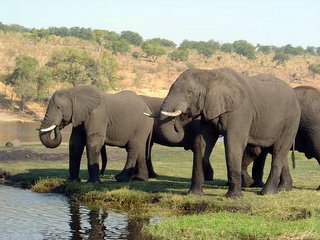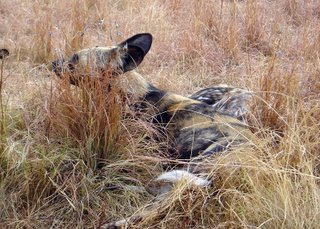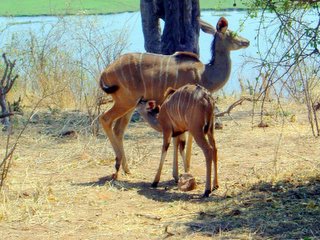

How to get there. Basically I drove from Johannesburg to Gaborone, the Capital of Botswana and caught an Air Botswana flight to Kasane about 5 kilometres from Chobe National Park.
Chobe is the second largest national park in Botswana and covers 10,566 square km. It takes its name from the Chobe river. Chobe has one of the greatest concentrations of game found on the African continent. Its uniqueness in the abundance of wildlife and the true African nature of the region, offers a safari experience of a lifetime.
 The park is divided into four distinctly different eco systems: Serondela with its lush plains and dense forests in the Chobe River area in the extreme north-east; the Savuti Marsh in the west; the Linyanti Swamps in the north-west the hot dry hinterland in between.A major feature of Chobe National Park is its elephant population currently estimated at around 120,000. Jesus! That's three times as many elephants as in all of South Africa. No wonder there's hardly any living trees in the place. Elephants are very destructive and tend to push over small trees to better reach to leaves. The Chobe elephants are migratory, making seasonal movements of up to 200 km from the Chobe and Linyanti rivers, where they concentrate in the dry season, to the pans in the southeast of the park, to which they disperse in the rains. As Chobe has no fence around it, the animals, including the lions, can roam about freely. I hired a 4WD to visit the northern section some 55 kilometres from Kasane and the Avis rep told me that two months ago there were lions just outside the loby of the Chobe Marine Lodge. One frequently sees elephants outside the park.
The park is divided into four distinctly different eco systems: Serondela with its lush plains and dense forests in the Chobe River area in the extreme north-east; the Savuti Marsh in the west; the Linyanti Swamps in the north-west the hot dry hinterland in between.A major feature of Chobe National Park is its elephant population currently estimated at around 120,000. Jesus! That's three times as many elephants as in all of South Africa. No wonder there's hardly any living trees in the place. Elephants are very destructive and tend to push over small trees to better reach to leaves. The Chobe elephants are migratory, making seasonal movements of up to 200 km from the Chobe and Linyanti rivers, where they concentrate in the dry season, to the pans in the southeast of the park, to which they disperse in the rains. As Chobe has no fence around it, the animals, including the lions, can roam about freely. I hired a 4WD to visit the northern section some 55 kilometres from Kasane and the Avis rep told me that two months ago there were lions just outside the loby of the Chobe Marine Lodge. One frequently sees elephants outside the park. 
 Chobe is often described as one of, if not the best, wildlife-viewing area in Africa today. It has of the highest concentrations of wildlife left on the African continent. Animals are present during all seasons, and at certain times of the year their numbers can be staggering. Especially the numbers of elephants. If you allow yourself adequate time here (a minimum of three to four days is recommended, I was there for five days) you will probably see nearly all the major species: giraffe, elephant, zebra, impala, tsessebe, roan, sable, wildebeest, kudu, buffalo, waterbuck, warthog, eland and accompanying predators including lion, hyena, jackal, bat-eared fox and possibly even cheetah and wild dog. I saw all but cheetah and leopards. There are plenty of hippo vultures and crocks. Savuti is famous for its predators, particularly its resident lions and spotted hyena populations. Mosquitoes are prevalent throughout the park and you need to take
Chobe is often described as one of, if not the best, wildlife-viewing area in Africa today. It has of the highest concentrations of wildlife left on the African continent. Animals are present during all seasons, and at certain times of the year their numbers can be staggering. Especially the numbers of elephants. If you allow yourself adequate time here (a minimum of three to four days is recommended, I was there for five days) you will probably see nearly all the major species: giraffe, elephant, zebra, impala, tsessebe, roan, sable, wildebeest, kudu, buffalo, waterbuck, warthog, eland and accompanying predators including lion, hyena, jackal, bat-eared fox and possibly even cheetah and wild dog. I saw all but cheetah and leopards. There are plenty of hippo vultures and crocks. Savuti is famous for its predators, particularly its resident lions and spotted hyena populations. Mosquitoes are prevalent throughout the park and you need to take anti-malarials and use generous quantities of insect repellent.
It's hard the do Chobe justice. It's beautiful and the wildlife is abundant. In many parks its hard to see elephants, but in Chobe there are so many that you literally must try to stay out of their way. Chobe comprises four main areas: the Chobe river frontage, the central pans around Nogatsaa, the Linyanti wetlands and the famous Savuti region that includes the Mababe Depression.
I did the river front by ferry and safari and I hired a 4WD and did the the Savuti.



Pictures: 1. Chobe elephants. 2. Wild dogs 3. Elephant
Elephant carcass, Chobe river front, 4 Zebras on the Savati,
5. Some type of African Tree (not very informed of me) 6. Calf suckling, 7. Hippo on Chobe river, 8. Giraffe (Savati). 9 Crocodile in the Chobe River

1 comment:
Great hippo. Love the giraffe. But you didn't sound as passionate in this blog. Must have been tired of it....
Post a Comment